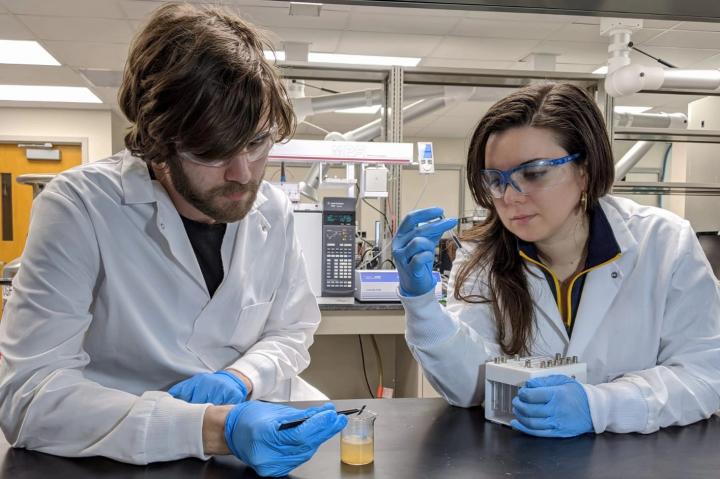Scientists are zeroing in on water quality and environmental concerns of fracking wastewater to determine if it is safe for reuse

Credit: Daniel Miller, The University of Toledo
Before water produced during hydraulic fracturing is disposed of in waterways or reused in agriculture and other industries, chemists at The University of Toledo are zeroing in on water quality and environmental concerns of fracking wastewater to determine if it is safe for reuse.
The research scientists of the new Dr. Nina McClelland Laboratory for Water Chemistry and Environmental Analysis at UToledo created a new method that simultaneously identified 201 chemical compounds in fracking wastewater, called produced water.
The research, which is published in the Journal of Separation Science and was carried out in collaboration with scientists at The University of Texas at Arlington, shows that many of the chemicals found in produced water are carcinogens, solvents and petroleum distillates that can directly contaminate drinking water sources.
“The issue with produced water is that this is a very new and overlooked source of pollution, and disposal and purification practices are not yet fully optimized to guarantee total removal of environmental pollutants,” said Dr. Emanuela Gionfriddo, assistant professor of analytical chemistry in the UToledo Department of Chemistry and Biochemistry and the School of Green Chemistry and Engineering. “Our work aimed to provide a new, simple and cost-effective method for the comprehensive characterization of chemicals and fill the gap of knowledge currently existing about the chemical composition of this waste product of the oil and natural gas industry.”
Scientists and natural gas companies are seeking creative ways to use produced water because current treatment processes to remove salts and radioactive substances – processes that include reverse osmosis and distillation – are expensive.
“Current methods for chemical characterization of produced water can give an estimate of the total amount of contamination but do not give information about what type of contamination is present,” Gionfriddo said. “It could be that a molecule can be still very toxic even if present at very low concentration, or it has the potential to accumulate in the body over time, so the point is to know exactly what is in produced water, not only how much.”
Gionfriddo’s research outlines how the chemists developed and optimized a thin-film, solid-phase microextraction approach to characterize the organic compounds in the produced water.
The team identified many chemicals, including a pesticide called atrazine; 1,4-dioxane, an organic compound that is irritating to the eyes and respiratory tract; toluene, which at low exposure has health effects like confusion, weakness, and loss of vision and hearing; and polycyclic aromatic hydrocarbons, which have been linked to skin, lung, bladder, liver and stomach cancers.
“There are many chemicals that still need to be identified at this time,” said Ronald Emmons, UToledo Ph.D. candidate. “More research also is needed to test the uptake of these chemicals in crops when produced water is recycled for agriculture. We need to study if and how these chemicals from the produced water can accumulate in the soil watered with produced water and if these chemicals can transfer from the soil to the crops.”
The collaborative research between UToledo and UT Arlington will continue using the new method for screening the presence of toxic molecules in produced water samples from various sampling sites in Texas.
UToledo scientists also are developing new methods for the extraction of heavy metals and rare earth elements that will aid the full characterization of produced water samples.
###
Media Contact
Christine Billau
[email protected]
Related Journal Article
http://dx.




